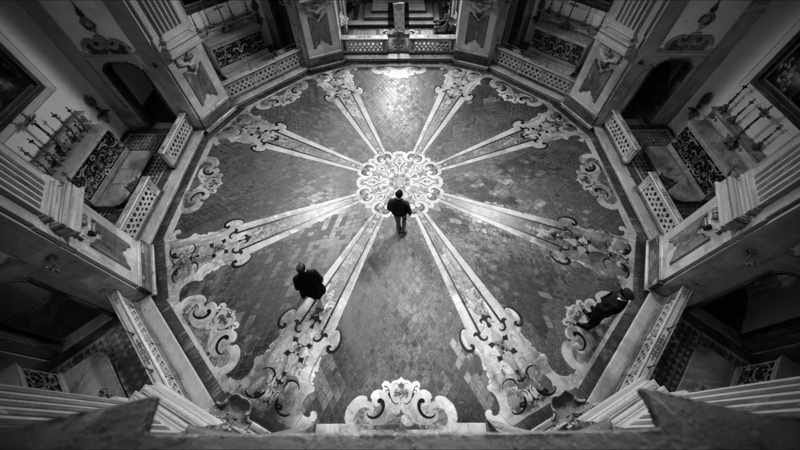The Talented Mr. Ripley, the first of the five “Ripliad” novels Patricia Highsmith wrote about the eponymous con man, came out in 1955. That was the year that Jonas Salk invented the polio vaccine: ten years after the bombs fell on Hiroshima and Nagasaki, and a year before the Federal Aid Highway Act kickstarted the construction of the Interstate Highway System. It may as well be a piece of detective fiction from the 1930s. Or a Victorian novel. Or something out of the Decameron.
By the mid-fifties, there were telephones and airplanes and TV sets and record players and motion pictures—hell, there were nuclear bombs—but in many ways, life in 1955 had more in common with life in, say, 1606 than 2024. The reason why is the technology. Think about it. My iPhone can be used to make calls, including video calls; send messages via text, email, or encrypted application; check the time; set an alarm; take pictures; take video footage; edit video; record audio; edit audio; broadcast myself in real time; access the vast store of human knowledge available on the internet; tune my guitar; read any book every published; listen to any piece of music that exists digitally; buy stuff; check if the stuff we bought has been delivered; broadcast messages that all the world can see; order food; make dinner reservations; buy tickets to concerts and movies; get directions to anyplace on earth; navigate; look at maps of anywhere; check the weather forecast; check my horoscope; check the phases of the moon; place wagers on live sporting events; book hotels and flights; rent cars; deposit checks; pay bills; call a cab; check the whereabouts of everyone in my family; send and receive money; buy and sell stocks; track my steps; monitor my heartrate; translate speech into other languages; find out the name of the song playing at the bar; watch video clips, TV shows, and movies; monitor security cameras; and control the thermostat remotely. There’s also a flashlight, a calculator, and a compass. All of this, literally in the palm of my hand.
Imagine going back in time to 1955, and explaining to Highsmith, pouring over her handwritten “cahiers,” banging out the manuscript on a manual typewriter, calling her editor from a rotary payphone on a dirty New York street, what the future had in store? The technology back then was primitive. Quaint, even. Everything took longer—everything. Before I-95, a simple drive from New York to Washington necessitated piloting slower, shittier, seatbeltless, stick-shift cars that broke down all the time along smaller, shittier, more perilous highways. Life was a journey.
One of the many pleasures of Ripley, the gorgeous eight-episode Netflix series written and directed by Steven Zaillian, is its slow, deliberate pacing. Tom Ripley’s schemes take weeks to unfold, and involve analog tech not often shown with such fidelity on the screen. A passport is altered through meticulous arts-and-crafts work, with scissors and glue and a dummy notary seal. Dickie Greenleaf’s signature is forged with the same expensive, and now completely obsolete, Mount Blanc fountain pen, and his letters faked with the use of Greenleaf’s own typewriter, with its quirky half-raised “e.” Much time is spent waiting in line at the bank, or stopping by the post office, or handing over the key to a hotel room.
Ripley is in every shot of the first four episodes, so we stay with him as he works and works and works, patiently and painstakingly, to keep up his grift. Technology is his enemy. The presence of a telephone—quite the rare luxury—in his Rome apartment only spells trouble, its ugly ring an alarm bell. Without it, would Freddie Miles have ever tracked him down? Certainly the assumption of another man’s identity—a man who looks nothing like him—would not fool law enforcement now, in the age of Facebook and Instagram and Fake Melanias, where there are photographs of everyone and anyone, there for the world to see.
Modern technology is about speed—about not wasting time. That is the promise of AI, the new shiny thing that quite suddenly has taken over our lives. AI can retouch photos and generate podcast transcripts and produce “deep fakes” of popular actresses doing porn. During the NBA playoffs, I sat through the same two commercials for Google Pixel hundreds of times, where “content creators” manipulate images to make a baby being tossed six inches into the air look like it’s being tossed six feet into the air, and where a man dancing in some European city modifies the background to enhance the video on his Insta reel. This week, Sam Altman, the next great tech idol who gives off strong Norman Bates vibes, essentially stole Scarlett Johansson’s voice because, allegedly, he wanted his AI thingie to sound like the cell phone in the film Her. Also this week, Google’s new AI search has failed spectacularly, as the artificial intelligence is not smart enough to distinguish the real from the satirical—the New York Times from the Onion.
All of this AI stuff, as I said, exists to save time, to save effort, and thus to enable all of us to create whatever we see in our minds, instantly, with a few strokes of a…well, not a pen, but you get the idea. Some of this is indeed useful, if not outright miraculous, but a lot of it feels frivolous. Do people really need the help of a computer to write a simple letter? Like, why must there be a deep fake of Emma Watson acting like a sex kitten? Are we now incapable of imagining erotic scenarios on our own? What—and I mean this quite literally—the fuck?
Today’s world can feel like the third act of a predictable sci-fi movie. Which makes Ripley all the more enjoyable. The show is shot in black and white, and every frame is beautiful, worthy of hanging on a wall in one of the museums Ripley visits as he endeavors to see all the Caravaggio paintings in Italy. This version of Ripley fancies himself an artist—more of one than Greenleaf, the dilettante who dabbles in painting, could ever be—and the show equates him with Caravaggio, another “talented” artist who killed a man.
Ripley is very much a period piece. The action takes place between the late fall of 1961 and the summer of 1962, which makes it all the more unnerving that Andrew Scott’s Ripley looks like, dresses like, and acts like Lee Harvey Oswald. For half of the show, he walks around in the same pants, the same shirt, the same ugly coat. He is markedly less attractive than Matt Damon in the 1999 version, let alone the gorgeous Alain Delon in 1960’s Purple Noon, the first film adaptation of Highsmith’s novel. Too, Johnny Flynn’s Dickie Greenleaf is not the embodiment of human perfection Jude Law, almost an AI-generated demigod, channels in The Talented Mr. Ripley. He’s just a shallow nepo baby, hoping against hope that some of the beauty and magic of the Amalfi Coast will rub off on him. His girlfriend, Marge Sherwood—wonderfully realized by Dakota Fanning—is likewise no Paltrovian paragon of virtuous girlfriendness, but just another flawed American seeking out artistic inspiration, and finding comfort, financial and otherwise, from Dickie. All of it feels real, believable, and intensely human.
Tom Ripley is the alter ego of his creator, Patricia Highsmith. She emerged from a troubled, unhappy childhood spent in both Texas and New York City hating her mother, while simultaneously being in love with her. She numbed her despair and self-loathing with alcohol and promiscuity. She was a Lesbian who loathed women, as she loathed Jews and the French—even as most of her lovers were Jewish, even as she lived for years in France.
What would Highsmith have made of modern technology? Probably she’d have despised it as she despised most things. She was a notorious grouch, after all, and grouches don’t like change. As she writes in the novel, Ripley “liked the fact that Venice had no cars. It made the city human. The streets were like veins, he thought, and the people were the blood, circulating everywhere.”
On the other hand, while Highsmith managed to orchestrate often complicated sexual liaisons on the daily without the aid of smartphones, one imagines her taking to the various dating apps with zeal. And reading about her over the weekend, this literary genius who went by “Pat” and wore men’s clothes and considered herself a man in a woman’s body, I get the impression that, if such avenues were open to her, if she’d been born 75 years later, she would have been trans, and a lot less miserable.
But the tragedy of 1955 is that it was more like 1606 than 2024. Today, paradoxically, our Silicon Valley wunderkinds propel us kicking and screaming into the brave new world, as our Republican politicians drag us, also kicking and screaming, back to the shameful, brutal past. Ripley made me feel like there’s nothing wrong with just being where we are.
ICYMI
Our guest on The Five 8 was the very funny Will Sebag-Montefiore:
ROUGH BEAST NEWS
Thanks to everyone for buying the book and leaving a review. The audiobook is coming soon, and bookstores should be able to order it this week.
Photo credit: Still shot from Ripley.






To be fair to Google's AI feature, it has gotten hard to distinguish between the New York Times and The Onion.
Sunday pages are always enlightening, so thanks Greg for sharing your research with us. Your work has been greatly appreciated by me and many others as proven by the replies here. The podcasts have been excellent of late especially Friday/your wife Stephanie! You both are amazing people and talented to boot. Enjoy this solemn holiday weekend.